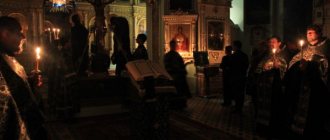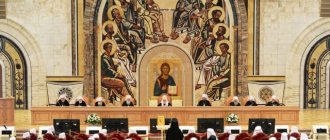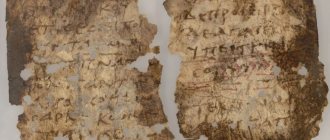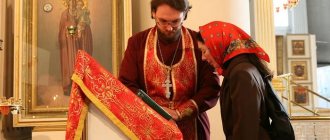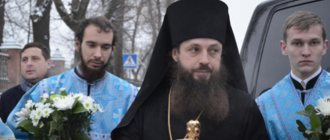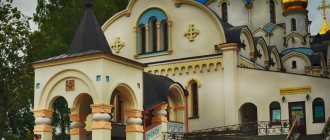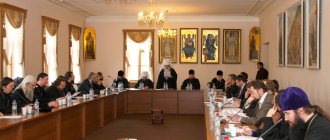Patriarchate in Russia
Patriarchate in Russia
– established in 1589 under Tsar Theodore Ioannovich. Already from the 15th century. The dependence of the Russian Church on the Patriarch of Constantinople was nominal; the conquest of Constantinople by the Turks completely reduced it, since in Rus' they even began to doubt the orthodoxy of the Patriarch and the entire Greek clergy. “The holy city of Constantinople, once obsessed with piety, perished for the sake of Latin charms” - the general opinion of that time. In 1480, a promise was included in the bishop's oath not to accept Greeks into the highest hierarchical departments. In 1586, taking advantage of the arrival of the Antiochian patriarch to Moscow for alms. Jokima, the tsar decided to end his nominal dependence on Byzantium, and, after discussing with the boyars and clergy, decided to establish a patriarchal throne in Moscow. So that there was no doubt, the Tsar and the Duma agreed to a stalemate. Iaokim to report this to the council of the Greek Church. A whole year passed without an answer. In 1588, Constantine arrived in Moscow. Patriarch Jeremiah and the Tsar again decisively raised the issue of IX, proposing that Jeremiah himself become the first Russian patriarch, with the condition that he live in Vladimir. Jeremiah refused to live outside the government. In fact, Moscow had its own candidate, Metropolitan Job, a protege of B. Godunov. In 1589, Job was installed by Jeremiah as a Russian patriarch; in 1591, a letter was received from the eastern clergy, signed by 3 patriarchs, 42 metropolitans, 19 archbishops. and 20 bishop. on the approval of P. in Moscow. Moscow patriarch. took place after Jerusalem, was chosen from the councils of hierarchs of the Russian Church. After the death of the patriarch, on behalf of the king, the guardian of the patriarch. throne, usually the metropolitan. Krutitsky, sent letters to all the highest clergy with an invitation to Moscow to elect a patriarch. Everyone appeared at the appointed time; if it was impossible to appear, each bishop had to send a letter stating that he agreed in advance with all the resolutions of the council. The council met in the presence of the sovereign in the “golden chamber of subscriptions”, the senior metropolitan “spoke worthily according to the hierarchical rite”, the tsar opened the council with a speech about the reason for the convening. Patr election form. was open or by lot, established after the death of Philaret. The names of 6 candidates from the senior hierarchs were written on 6 pieces of paper of equal size, the pieces of paper were doused with wax on all sides, sealed with the royal seal and sent to the council, which was meeting at that time in Moscow. Assumption Cathedral. Three lots were placed on the panagia of the deceased patriarch; then all members of the cathedral put on vestments and served an akathist to the Mother of God, after which 2 were taken out of 3 lots and put aside. They did the same with the other three. Thus, two lots remained; One was taken out of them, which contained the name of the elected patriarch. The unopened lot was given to the boyar, who took it to the king; the tsar unsealed it and again announced to the cathedral through the boyar the name of the chosen one. Thus, the council elected from candidates appointed by the king. At the beginning they wanted to divide the church into metropolitan districts, embracing several dioceses, but the division did not take place. 4 bishops - Novgorod, Kazan, Rostov and Krutitsy - received the rank of metropolitan, but the dioceses reported directly to the patriarch. Legally, the patriarch was no different from the former metropolitan; he enjoyed only certain liturgical advantages. Like the Metropolitan, he wore a large hood, but with cherubs or a cross; on his miter he also had a cross, which the metropolitan did not have; He, unlike other bishops, vested himself not in the altar, but in the middle of the church; only one sat in a high place; gave communion to the bishops from his own hands; wore a colored robe; Not only a cross, but also candles were carried in front of him during exits or departures. Russian patriarchs achieved great importance, especially due to the troubled times. The first of them, 1) Job, actively worked in favor of the election of Godunov as king; thanks to him, Boris was not limited in his rights; When False Demetrius appeared, Job persistently and energetically defended Boris and his son Theodore against him, sending letters everywhere stating that False Demetrius was an impostor, a thief and a fugitive miracle monk, Grishka Otrepiev, and finally anathematized him. When the impostor took possession of Moscow, he overthrew Job from the throne and ordered him to be imprisoned in a simple monastic robe in the Staritsky Monastery. The first of the bishops who recognized False Demetrius as the true king was the Ryazan bishop. 2) Ignatius, a Greek by birth, raised in Rome and a former bishop before coming to Russia. Cyprus. In gratitude, False Dmitry elevated him to patriarch in 1605. After the overthrow of False Demetrius, Ignatius moved to Lithuania, where he accepted the union. 3) Hermogenes, who was the most in opposition to False Demetrius, was chosen as the new patriarch. Hermogenes was by nature a powerful and even stern person, but very strict with himself, straightforward and persistent. Not loving Vasily Shuisky, he still defended him as a crowned king. When the Tushino thief appeared, Hermogenes organized a patrol in Moscow in the presence of a man summoned from Staritsa, who had gone blind. Job, a solemn repentant procession, during which the patriarchs absolved the sins of the repentant people. At the beginning of 1609, those dissatisfied with Shuisky dragged Hermogenes to the place of execution and, shaking him by the collar, demanded his consent to change the king; however, he was not afraid of the crowd and torment and remained firm. After the overthrow of Shuisky, when the boyars nominated the Polish prince Vladislav, Hermogenes agreed on the condition that Vladislav convert to Orthodoxy. Negotiations with Sigismund and Vladislav ended unsuccessfully and the Russian ambassadors, Rostov Metropolitan Philaret and Prince Golitsyn, were detained in captivity in Marienburg in 1611. Then Hermogenes allowed the Russians to swear allegiance to Vladislav and began to call on the people to defend the state and Orthodoxy. With the exception of the Polish party of boyars led by Saltykov, who were hostile to Hermogenes, the entire Russian land did not want to recognize another leadership; Zemstvo militias began to be sent from everywhere; The party of Polish boyars demanded that he turn them back, but Hermogenes blessed the militia and cursed the traitors, for which he was imprisoned, where in 1612 he died, as they say, starved to death. The Kazan Metropolitan began to govern the church temporarily. Ephraim, after his death - Metropolitan Jonah of Krutitsa, an uneducated, stubborn and vindictive man. Until 1619, the church remained without a patriarch, and only this year Tsar Michael, taking advantage of the stay of the Jerusalem patriarch in Moscow. Feofan, raised his father to Rostov. Metropolitan 4) Filaret, who returned from Polish captivity to become a patriarch. From now on, there was complete dual power: as Michael’s father, Filaret received the title of “great sovereign” in the sphere of church government. and he ruled the court independently; from 1625 he was in charge of the court of all clergy and monastic ministers and peasants in all cases, except criminal ones; Philaret had his own courtyard, like the royal one, his own candle makers, tablecloth makers, cup makers, stokers, grooms, cooks, bakers, brewers, icon painters; his boyars, okolnichy, solicitors, stewards, nobles, boyar children, to whom he entrusted various branches of government. Under him, separate ranks and orders began to be allocated; court order or patriarchal rank; the state order, which was in charge of affairs about proteges and about collections from estates and the clergy, the palace order, which was in charge of the patriarch’s household; order of church affairs, in charge of the affairs of the Church deanery and others. After the death of Philaret, 5) Joasaph I was patriarch from 1634 to 1640; Joasaph no longer bore the title of “great sovereign” and generally did not occupy the same position as Philaret. After Joasaph, 6) there was Joseph from 1640 to 1652, who also did not have the title of “great sovereign.” Under him, the Code of 1649 was issued, which significantly reduced the importance of the church hierarchy and the patriarch, abolishing the judicial privileges of the clergy with the establishment of a special monastic order. The next 7) patriarch was Nikon (about him, see the words Nikon), under whom Patr. power reached its apogee. During Nikon's removal, before his trial, the church was ruled by the Metropolitan. Krutitsky Pitirim. The verdict over Nikon was at the same time the verdict over P. in Russia: the council of 1667 recognized that the patriarch should not bear the title of “great sovereign” and should not interfere in worldly affairs; it became obvious that Patr. He is not omnipotent and his power is not the autocracy of a king. On the other hand, the council of 1667 recognized Patr. independence in church and clergy affairs. Joasaph II, 1667–1673, a very quiet and insignificant man, was elected patriarch Starting with him, P. lost its state significance. After Joasaph II, the patriarchs were 9) Pitirim in 1673, 10) Joachim Savelov, 1673–1690, 11) Adrian 1690–1700. They did not play a major role and only sought to preserve the privileges of the clergy, especially judicial ones. In 1675 the monastery order was closed; in 1689, the Novgorodians petitioned Joachim to have clergy tried in the court chamber, and not in the metropolitan court; however, Joachim threatened them with the judgment of Korah, Dathan and Abiron. Russia's rapprochement with the West aroused opposition from Joachim and Adrian. Limited and unable to rise above the routine of antiquity, they in every possible way hindered reforms, seeing an undermining of religion even in a change in the appearance of a Russian person. Naturally, the patriarch, not imbued with the spirit of the times, turned out to be superfluous. The short-sighted Joachim in his will demanded that the government not get closer to Europe; Adrian also tried to follow in his footsteps; however, Peter limited it; Adrian lived not in Moscow, but in his Perervinsky monastery, and there, without expressing dissatisfaction out loud, he silently stood at the head of the unborn, who did not understand the full importance of Peter’s reforms. Peter began to be burdened by the patriarchate, since in the person of the patriarch he always saw an enemy, a symbol of discontent, a force that threatened to erase all his good undertakings after his death. Therefore, when Adrian died in 1700, Peter, not immediately daring to put an end to P., appointed a locum tenens patriarch. throne in the person of his associate, Metropolitan. Ryazan Stefan Yavorsky. Already the appointment as locum tenens of the Ryazan Metropolitan, and not of Krutitsky, is news; the locum tenens had all the rights of the patriarch; he had with him an advisory council of regular bishops from the diocese. In 1718, Peter, replacing orders with colleges, replaced the sole power of the patriarch with a spiritual college (later the Holy Synod), a permanent council of spiritual government.
Already from the 15th century. The dependence of the Russian Church on the Patriarch of Constantinople was nominal; the conquest of Constantinople by the Turks completely reduced it, since in Rus' they even began to doubt the orthodoxy of the Patriarch and the entire Greek clergy. “The holy city of Constantinople, once obsessed with piety, perished for the sake of Latin charms” - the general opinion of that time. In 1480, a promise was included in the bishop's oath not to accept Greeks into the highest hierarchical departments. In 1586, taking advantage of the arrival of the Antiochian patriarch to Moscow for alms. Jokima, the tsar decided to end his nominal dependence on Byzantium, and, after discussing with the boyars and clergy, decided to establish a patriarchal throne in Moscow. So that there was no doubt, the Tsar and the Duma agreed to a stalemate. Iaokim to report this to the council of the Greek Church. A whole year passed without an answer. In 1588, Constantine arrived in Moscow. Patriarch Jeremiah and the Tsar again decisively raised the issue of IX, proposing that Jeremiah himself become the first Russian patriarch, with the condition that he live in Vladimir. Jeremiah refused to live outside the government. In fact, Moscow had its own candidate, Metropolitan Job, a protege of B. Godunov. In 1589, Job was installed by Jeremiah as a Russian patriarch; in 1591, a letter was received from the eastern clergy, signed by 3 patriarchs, 42 metropolitans, 19 archbishops. and 20 bishop. on the approval of P. in Moscow. Moscow patriarch. took place after Jerusalem, was chosen from the councils of hierarchs of the Russian Church. After the death of the patriarch, on behalf of the king, the guardian of the patriarch. throne, usually the metropolitan. Krutitsky, sent letters to all the highest clergy with an invitation to Moscow to elect a patriarch. Everyone appeared at the appointed time; if it was impossible to appear, each bishop had to send a letter stating that he agreed in advance with all the resolutions of the council. The council met in the presence of the sovereign in the “golden chamber of subscriptions”, the senior metropolitan “spoke worthily according to the hierarchical rite”, the tsar opened the council with a speech about the reason for the convening. Patr election form. was open or by lot, established after the death of Philaret. The names of 6 candidates from the senior hierarchs were written on 6 pieces of paper of equal size, the pieces of paper were doused with wax on all sides, sealed with the royal seal and sent to the council, which was meeting at that time in Moscow. Assumption Cathedral. Three lots were placed on the panagia of the deceased patriarch; then all members of the cathedral put on vestments and served an akathist to the Mother of God, after which 2 were taken out of 3 lots and put aside. They did the same with the other three. Thus, two lots remained; One was taken out of them, which contained the name of the elected patriarch. The unopened lot was given to the boyar, who took it to the king; the tsar unsealed it and again announced to the cathedral through the boyar the name of the chosen one. Thus, the council elected from candidates appointed by the king. At the beginning they wanted to divide the church into metropolitan districts, embracing several dioceses, but the division did not take place. 4 bishops - Novgorod, Kazan, Rostov and Krutitsy - received the rank of metropolitan, but the dioceses reported directly to the patriarch. Legally, the patriarch was no different from the former metropolitan; he enjoyed only certain liturgical advantages. Like the Metropolitan, he wore a large hood, but with cherubs or a cross; on his miter he also had a cross, which the metropolitan did not have; He, unlike other bishops, vested himself not in the altar, but in the middle of the church; only one sat in a high place; gave communion to the bishops from his own hands; wore a colored robe; Not only a cross, but also candles were carried in front of him during exits or departures. Russian patriarchs achieved great importance, especially due to the troubled times. The first of them, 1) Job, actively worked in favor of the election of Godunov as king; thanks to him, Boris was not limited in his rights; When False Demetrius appeared, Job persistently and energetically defended Boris and his son Theodore against him, sending letters everywhere stating that False Demetrius was an impostor, a thief and a fugitive miracle monk, Grishka Otrepiev, and finally anathematized him. When the impostor took possession of Moscow, he overthrew Job from the throne and ordered him to be imprisoned in a simple monastic robe in the Staritsky Monastery. The first of the bishops who recognized False Demetrius as the true king was the Ryazan bishop. 2) Ignatius, a Greek by birth, raised in Rome and a former bishop before coming to Russia. Cyprus. In gratitude, False Dmitry elevated him to patriarch in 1605. After the overthrow of False Demetrius, Ignatius moved to Lithuania, where he accepted the union. 3) Hermogenes, who was the most in opposition to False Demetrius, was chosen as the new patriarch. Hermogenes was by nature a powerful and even stern person, but very strict with himself, straightforward and persistent. Not loving Vasily Shuisky, he still defended him as a crowned king. When the Tushino thief appeared, Hermogenes organized a patrol in Moscow in the presence of a man summoned from Staritsa, who had gone blind. Job, a solemn repentant procession, during which the patriarchs absolved the sins of the repentant people. At the beginning of 1609, those dissatisfied with Shuisky dragged Hermogenes to the place of execution and, shaking him by the collar, demanded his consent to change the king; however, he was not afraid of the crowd and torment and remained firm. After the overthrow of Shuisky, when the boyars nominated the Polish prince Vladislav, Hermogenes agreed on the condition that Vladislav convert to Orthodoxy. Negotiations with Sigismund and Vladislav ended unsuccessfully and the Russian ambassadors, Rostov Metropolitan Philaret and Prince Golitsyn, were detained in captivity in Marienburg in 1611. Then Hermogenes allowed the Russians to swear allegiance to Vladislav and began to call on the people to defend the state and Orthodoxy. With the exception of the Polish party of boyars led by Saltykov, who were hostile to Hermogenes, the entire Russian land did not want to recognize another leadership; Zemstvo militias began to be sent from everywhere; The party of Polish boyars demanded that he turn them back, but Hermogenes blessed the militia and cursed the traitors, for which he was imprisoned, where in 1612 he died, as they say, starved to death. The Kazan Metropolitan began to govern the church temporarily. Ephraim, after his death - Metropolitan Jonah of Krutitsa, an uneducated, stubborn and vindictive man. Until 1619, the church remained without a patriarch, and only this year Tsar Michael, taking advantage of the stay of the Jerusalem patriarch in Moscow. Feofan, raised his father to Rostov. Metropolitan 4) Filaret, who returned from Polish captivity to become a patriarch. From now on, there was complete dual power: as Michael’s father, Filaret received the title of “great sovereign” in the sphere of church government. and he ruled the court independently; from 1625 he was in charge of the court of all clergy and monastic ministers and peasants in all cases, except criminal ones; Philaret had his own courtyard, like the royal one, his own candle makers, tablecloth makers, cup makers, stokers, grooms, cooks, bakers, brewers, icon painters; his boyars, okolnichy, solicitors, stewards, nobles, boyar children, to whom he entrusted various branches of government. Under him, separate ranks and orders began to be allocated; court order or patriarchal rank; the state order, which was in charge of affairs about proteges and about collections from estates and the clergy, the palace order, which was in charge of the patriarch’s household; order of church affairs, in charge of the affairs of the Church deanery and others. After the death of Philaret, 5) Joasaph I was patriarch from 1634 to 1640; Joasaph no longer bore the title of “great sovereign” and generally did not occupy the same position as Philaret. After Joasaph, 6) there was Joseph from 1640 to 1652, who also did not have the title of “great sovereign.” Under him, the Code of 1649 was issued, which significantly reduced the importance of the church hierarchy and the patriarch, abolishing the judicial privileges of the clergy with the establishment of a special monastic order. The next 7) patriarch was Nikon (about him, see the words Nikon), under whom Patr. power reached its apogee. During Nikon's removal, before his trial, the church was ruled by the Metropolitan. Krutitsky Pitirim. The verdict over Nikon was at the same time the verdict over P. in Russia: the council of 1667 recognized that the patriarch should not bear the title of “great sovereign” and should not interfere in worldly affairs; it became obvious that Patr. He is not omnipotent and his power is not the autocracy of a king. On the other hand, the council of 1667 recognized Patr. independence in church and clergy affairs. Joasaph II, 1667–1673, a very quiet and insignificant man, was elected patriarch Starting with him, P. lost its state significance. After Joasaph II, the patriarchs were 9) Pitirim in 1673, 10) Joachim Savelov, 1673–1690, 11) Adrian 1690–1700. They did not play a major role and only sought to preserve the privileges of the clergy, especially judicial ones. In 1675 the monastery order was closed; in 1689, the Novgorodians petitioned Joachim to have clergy tried in the court chamber, and not in the metropolitan court; however, Joachim threatened them with the judgment of Korah, Dathan and Abiron. Russia's rapprochement with the West aroused opposition from Joachim and Adrian. Limited and unable to rise above the routine of antiquity, they in every possible way hindered reforms, seeing an undermining of religion even in a change in the appearance of a Russian person. Naturally, the patriarch, not imbued with the spirit of the times, turned out to be superfluous. The short-sighted Joachim in his will demanded that the government not get closer to Europe; Adrian also tried to follow in his footsteps; however, Peter limited it; Adrian lived not in Moscow, but in his Perervinsky monastery, and there, without expressing dissatisfaction out loud, he silently stood at the head of the unborn, who did not understand the full importance of Peter’s reforms. Peter began to be burdened by the patriarchate, since in the person of the patriarch he always saw an enemy, a symbol of discontent, a force that threatened to erase all his good undertakings after his death. Therefore, when Adrian died in 1700, Peter, not immediately daring to put an end to P., appointed a locum tenens patriarch. throne in the person of his associate, Metropolitan. Ryazan Stefan Yavorsky. Already the appointment as locum tenens of the Ryazan Metropolitan, and not of Krutitsky, is news; the locum tenens had all the rights of the patriarch; he had with him an advisory council of regular bishops from the diocese. In 1718, Peter, replacing orders with colleges, replaced the sole power of the patriarch with a spiritual college (later the Holy Synod), a permanent council of spiritual government.
History of the Patriarchate
Estimated reading time: less than a minute.
ON NOVEMBER 21, 1917, the enthronement of Patriarch of Moscow and All Rus' Tikhon took place. “Your own comrades called you “patriarch” when you were still a layman, when neither they nor you yourself could even think about the actual implementation of such a name,” Metropolitan Anthony Khrapovitsky addressed the named Patriarch Tikhon with such a speech. Who were the predecessors of Patriarch Tikhon? And is it surprising that the Metropolitan became Patriarch?
The special metropolitanate of the Patriarchate of Constantinople was the official position of the Russian Orthodox Church for the first six centuries of its existence. But time passed. Greece found itself under the most severe Muslim yoke. And the Moscow kingdom rose, became richer and stronger. Since the middle of the 15th century, metropolitans in Rus' have been elected without communication with the Patriarch of Constantinople.
“You will have a fifth place under the Patriarch of Jerusalem,” a message with these words was received by the first Patriarch of the Russian Orthodox Church, Saint Job, from the primates of the Antioch, Constantinople, Alexandria and Jerusalem Churches in 1591. Now the Moscow patriarch is equal to others in terms of independence, advantages and hierarchical honor.
Saint Hermogenes became the first patriarch of the Russian Church, who had to take care not only of spiritual, but also of state affairs. Before his eyes, the impostor False Dmitry, with the help of the Polish occupiers, tried to seize the Russian throne, which was left without legitimate heirs. The saint sent out letters calling on people to rebel against the invaders. For this, the Poles took His Holiness into custody and starved him to death.
Nikon was, perhaps, the only patriarch who “officially” replaced the tsar during his absences. The boyars came with a report on worldly and military affairs to the head of the Church, and, it seems, they feared his court more than the sovereign's. The ardor of his nature ultimately led Nikon to exile... And only eight months after his death did the ecumenical patriarchs decide with their letters that this great man of the Russian Church was worthy of his high rank, although he temporarily experienced temptation and sorrow.
The reformer Peter I realized that among his clergy compatriots there were no people inclined to support changes in the state. In 1721, he established the Holy Synod, a body for the collegial management of church affairs, subordinate to the state, thereby essentially abolishing the institution of the patriarchate in Rus'.
In 1917, the entire familiar way of Russian life crumbled to dust. The Church was forced to immediately respond to the challenge of the time and at the Local Council of 1917 made a decision to elect a Patriarch. On November 18, the lot fell on Metropolitan Tikhon of Moscow and Kolomna. Having become the first Patriarch of All Rus' after a two-hundred-year break, Saint Tikhon, in the conditions of the Civil War, mass arrests and atrocities, was able to re-organize church-wide administration and determine the form of relations between the Church and the communist state for several decades to come.
November 18 is one of the days of memory of St. Tikhon , Patriarch of Moscow and All Russia (election 1917)
The author of the drawings is Elena Popovskaya

